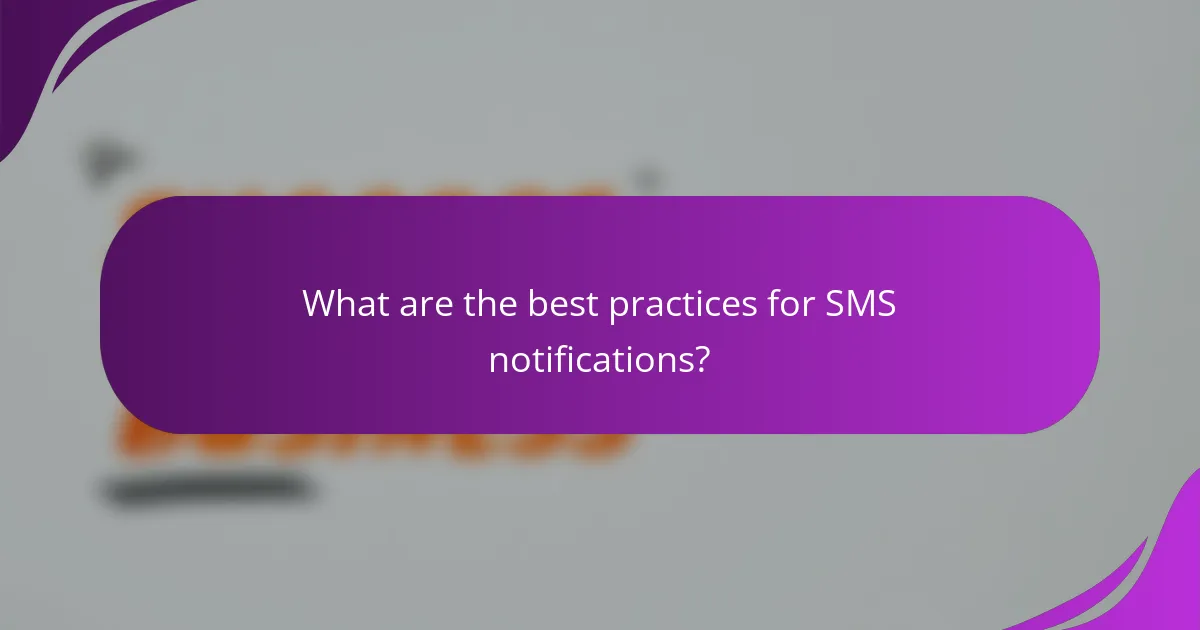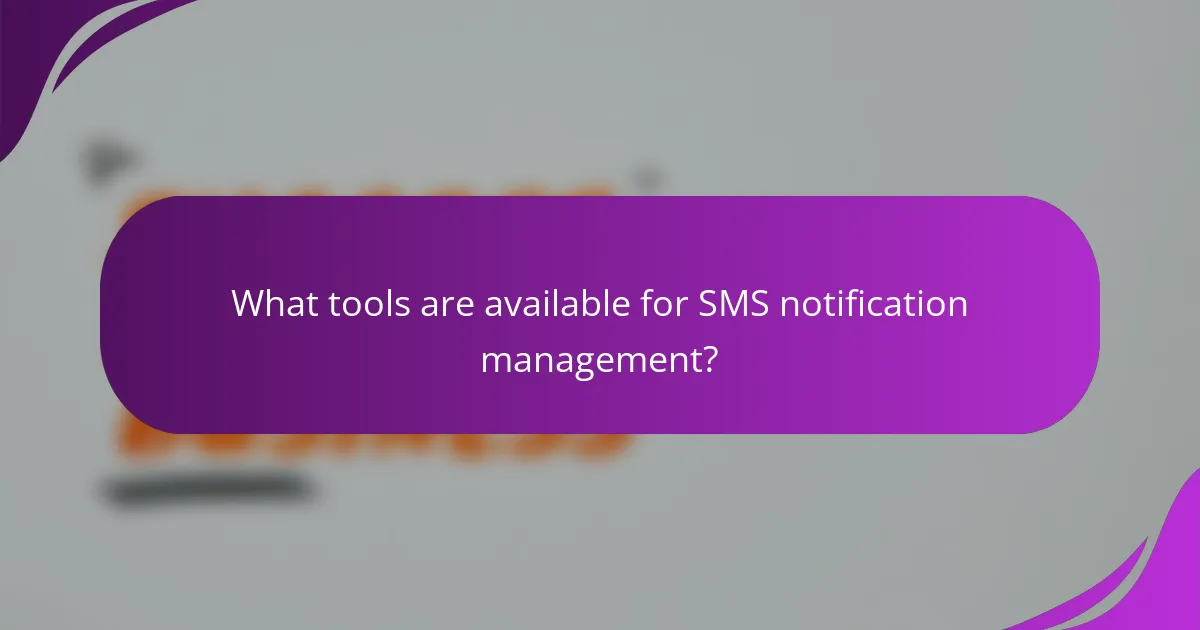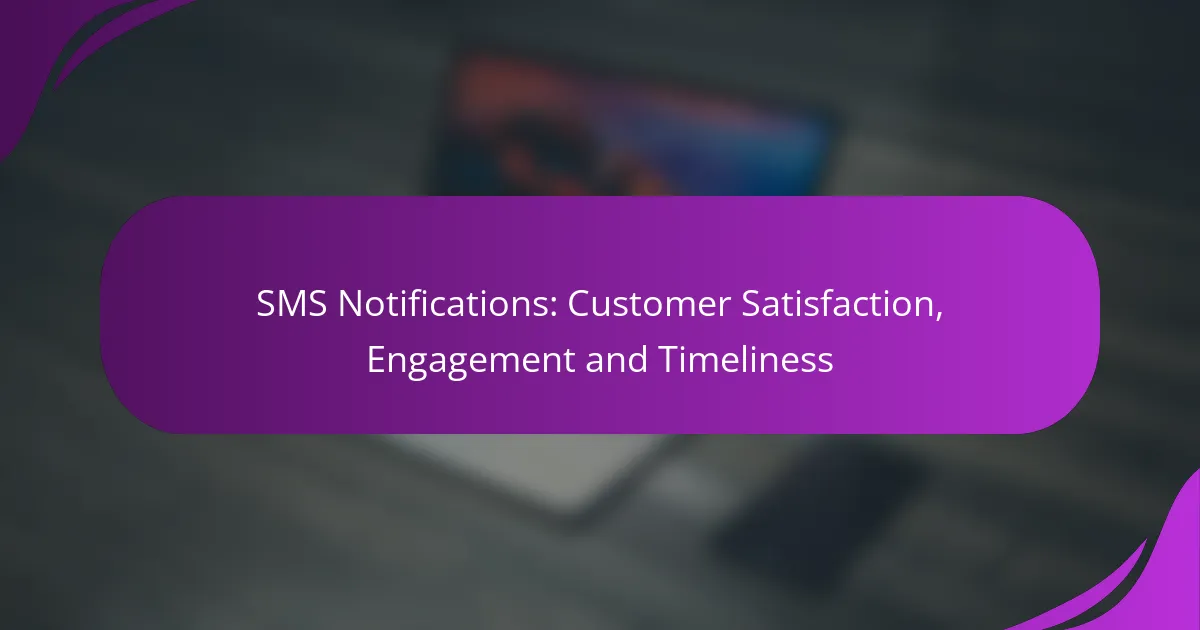SMS notifications play a crucial role in enhancing customer satisfaction by delivering timely updates and fostering direct communication. By engaging customers effectively, businesses can ensure that their audience feels valued and informed, ultimately leading to improved interactions and loyalty.

How do SMS notifications enhance customer satisfaction in the UK?
SMS notifications significantly enhance customer satisfaction in the UK by providing timely updates and fostering direct communication. These messages allow businesses to engage customers effectively, ensuring they feel valued and informed throughout their interactions.
Immediate feedback opportunities
SMS notifications create immediate feedback opportunities by allowing customers to respond quickly to inquiries or service requests. For instance, after a purchase, a simple text asking for feedback can yield responses within minutes, enabling businesses to address concerns promptly.
Additionally, businesses can use SMS to conduct quick surveys or polls, gathering insights that can lead to immediate improvements in service or product offerings. This responsiveness not only boosts satisfaction but also builds customer loyalty.
Personalized communication
Personalized communication through SMS notifications enhances the customer experience by making interactions feel tailored to individual needs. By using customer data, businesses can send targeted messages about promotions, reminders, or updates that are relevant to each recipient.
For example, a restaurant might send a personalized message to a customer on their birthday, offering a special discount. This kind of thoughtful communication fosters a sense of connection and appreciation, leading to higher satisfaction levels.
Increased response rates
SMS notifications typically achieve higher response rates compared to email or other communication methods. Studies suggest that SMS messages have open rates exceeding 90%, making them an effective tool for engaging customers.
To maximize response rates, businesses should keep messages concise and clear, focusing on a single call to action. For instance, a reminder for an upcoming appointment or a limited-time offer can prompt immediate responses, enhancing overall engagement and satisfaction.

What are the best practices for SMS notifications?
The best practices for SMS notifications focus on delivering clear, timely messages that enhance customer satisfaction and engagement. Implementing effective strategies for messaging, timing, and user consent can significantly improve the overall effectiveness of SMS communication.
Clear and concise messaging
Clear and concise messaging is crucial for effective SMS notifications. Messages should be straightforward, avoiding jargon and unnecessary details, to ensure recipients understand the content quickly. Aim for a character limit of around 160 characters to maintain clarity.
For example, instead of saying, “Your order has been processed and will be shipped shortly,” consider a simpler message like, “Your order is on the way!” This direct approach keeps customers informed without overwhelming them.
Timing and frequency considerations
Timing and frequency are essential factors in SMS notifications. Messages should be sent at appropriate times to maximize engagement, typically during business hours or when customers are likely to be available. Avoid sending messages late at night or during early morning hours.
Frequency should also be managed carefully. Sending too many messages can lead to customer annoyance and opt-outs. A good rule of thumb is to limit promotional messages to a few times a month, while transactional messages can be sent as needed.
Opt-in and opt-out processes
Establishing clear opt-in and opt-out processes is vital for compliance and customer trust. Customers should easily understand how to subscribe to SMS notifications, often through a simple text message or online form. Ensure that the opt-in process is straightforward and transparent.
Equally important is the opt-out option, which should be just as easy. Customers should be able to unsubscribe at any time, typically by replying with “STOP.” This not only complies with regulations but also helps maintain a positive relationship with your audience.

How can businesses measure engagement through SMS notifications?
Businesses can measure engagement through SMS notifications by tracking key performance indicators such as response rates, customer feedback, and various engagement metrics. These measurements help businesses understand how effectively their SMS campaigns resonate with customers and drive desired actions.
Tracking response rates
Tracking response rates involves monitoring how many recipients engage with SMS messages, such as by replying or clicking on links. A typical response rate for SMS campaigns can range from 10% to 30%, depending on the industry and the relevance of the content. Businesses should set clear goals for response rates to evaluate the effectiveness of their messaging.
To track response rates, use unique links or codes in SMS messages that allow for easy identification of customer interactions. This data can help refine messaging strategies and improve future campaigns.
Analyzing customer feedback
Analyzing customer feedback is crucial for understanding the impact of SMS notifications on customer satisfaction. Businesses can gather feedback through direct replies to SMS, surveys sent via text, or by monitoring social media mentions. This qualitative data provides insights into customer perceptions and areas for improvement.
Encouraging customers to provide feedback after receiving an SMS can enhance engagement. For example, a simple follow-up message asking for their thoughts on a recent promotion can yield valuable insights and foster a sense of connection.
Utilizing engagement metrics
Utilizing engagement metrics involves assessing various data points such as open rates, click-through rates, and conversion rates. Open rates for SMS notifications are generally high, often exceeding 90%, making them a reliable channel for reaching customers. However, tracking click-through rates can provide deeper insights into how engaging the content is.
Businesses should regularly analyze these metrics to identify trends and adjust their SMS strategies accordingly. For instance, if click-through rates are low, it may indicate that the content needs to be more compelling or relevant to the audience.

What tools are available for SMS notification management?
Several tools are available for managing SMS notifications, each offering unique features tailored for different needs. These platforms enable businesses to automate messaging, engage customers, and ensure timely communication.
Twilio for SMS automation
Twilio is a robust platform that specializes in SMS automation, allowing businesses to send and receive messages programmatically. It offers APIs that can integrate with various applications, making it ideal for developers looking to automate notifications and alerts.
With Twilio, you can set up automated workflows for reminders, confirmations, or promotional messages. Pricing is typically based on usage, with costs per message sent, making it scalable for businesses of all sizes.
Sendinblue for marketing campaigns
Sendinblue is designed for comprehensive marketing campaigns, including SMS notifications. It enables users to create targeted campaigns based on customer behavior and preferences, enhancing engagement.
This tool allows for segmentation and personalization, which can significantly improve response rates. Sendinblue often offers competitive pricing plans that include a certain number of SMS messages per month, making it cost-effective for small to medium-sized businesses.
TextMagic for customer communication
TextMagic focuses on customer communication, providing an easy-to-use platform for sending SMS notifications. It is particularly useful for businesses that need to communicate directly with customers for confirmations, updates, or support.
The platform supports bulk messaging, which is beneficial for reaching large audiences quickly. TextMagic operates on a pay-as-you-go model, allowing businesses to manage costs effectively while ensuring timely communication with their customers.

What are the compliance considerations for SMS notifications in the UK?
In the UK, compliance considerations for SMS notifications primarily revolve around data protection laws and privacy regulations. Businesses must ensure that their SMS practices align with the General Data Protection Regulation (GDPR) and other relevant privacy laws to avoid penalties and maintain customer trust.
GDPR regulations
The General Data Protection Regulation (GDPR) sets strict guidelines for the processing of personal data, including SMS notifications. Under GDPR, businesses must have a lawful basis for sending SMS messages, which typically includes obtaining explicit consent from the recipient.
Additionally, companies must ensure that recipients can easily withdraw consent at any time. This means providing clear opt-out options in every SMS message, allowing customers to manage their preferences effectively.
Privacy and consent requirements
Privacy and consent requirements dictate that businesses must inform customers about how their data will be used when they opt-in for SMS notifications. This includes specifying the types of messages they will receive and the frequency of these communications.
It is crucial to maintain a record of consent for compliance purposes. Businesses should implement a straightforward process for customers to give and revoke consent, ensuring transparency and fostering trust in their communication practices.

How do SMS notifications improve timeliness in customer communication?
SMS notifications enhance timeliness in customer communication by delivering messages instantly to users’ mobile devices. This immediacy ensures that important updates, reminders, or alerts reach customers without delay, fostering a more responsive interaction.
Instant Delivery and Read Rates
SMS notifications are typically delivered within seconds, with read rates exceeding 90% shortly after receipt. This rapid delivery and high engagement mean that customers are more likely to receive and act on critical information promptly.
Real-Time Updates
Using SMS for real-time updates allows businesses to inform customers about order statuses, appointment reminders, or service disruptions as they happen. For example, a restaurant can send an SMS to notify patrons of a table availability or a delay, ensuring they are informed immediately.
Improved Customer Engagement
Timely SMS notifications can significantly enhance customer engagement by prompting immediate responses. For instance, sending a promotional offer via SMS shortly before an event can encourage customers to take action, increasing participation and sales.
Considerations for Implementation
When implementing SMS notifications, businesses should consider the frequency and timing of messages to avoid overwhelming customers. A good practice is to limit notifications to essential updates and ensure they are sent during appropriate hours to respect customers’ privacy.
Regulatory Compliance
Businesses must comply with regulations such as the Telephone Consumer Protection Act (TCPA) in the U.S. or GDPR in Europe when sending SMS notifications. Obtaining explicit consent from customers before sending messages is crucial to avoid legal issues and maintain trust.
